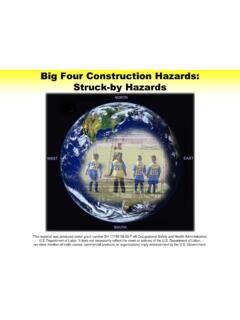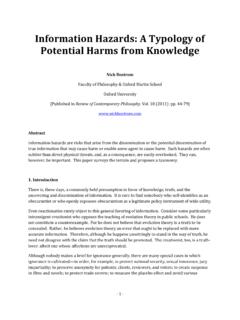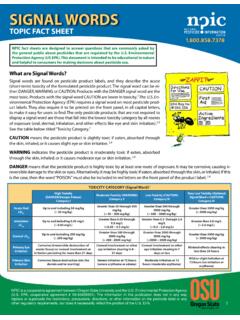Transcription of UNIT IV
1 NATURAL hazards AND DISASTERS:CAUSES, CONSEQUENCES AND MANAGEMENTThis unit deals with Floods and droughts Earthquakes and tsunami Cyclones LandslidesUNITIV2015-16(20/01/2015)You might have read about tsunami orseen the images of horror ontelevision set immediately after ithappened. You may also be aware of the severeearthquake in Kashmir on both sides of theLine of Control (LOC). The damage caused tohuman life and properties during theseepisodes has moved us all. What are these asphenomena and how they are caused? Howcan we save ourselves? These are somequestions which come to our minds. Thischapter will attempt to analyse some of is the law of nature. It is a continuousprocess that goes on uninterruptedly involvingphenomena, big and small, material and non-material that make our physical and socio-cultural environment. It is a process presenteverywhere with variations in terms ofmagnitude, intensity and scale.
2 Change can bea gradual or slow process like the evolution oflandforms and organisms and it can be assudden and swift as volcanic eruptions,tsunamis, earthquakes and lightening, , it may remain confined to a smallerarea occurring within a few seconds likehailstorms, tornadoes and dust storms, and itcan also have global dimensions such as globalwarming and depletion of the ozone these, changes have differentmeanings for different people. It depends uponthe perspective one takes while trying tounderstand them. From the perspective ofnature, changes are value-neutral (these areneither good nor bad). But from the humanperspective, these are value-loaded. There aresome changes that are desirable and good likethe change of seasons, ripening of fruits, whilethere are others like earthquakes, floods andwars that are considered bad and the environment you live in andprepare a list of changes, which takeplace over a long period of time andthose, which take place within a shortperiod of time.
3 Do you know why somechanges are considered good and othersbad? Prepare a list of changes, whichyou notice in your daily life and givereasons why some of these areconsidered good and others this chapter, we will read about some ofthese changes, which are considered bad andhave haunted humankind for a long in general and natural disastersin particular, are some such changes that arealways disliked and feared by is a Disaster? Disaster is an undesirable occurrenceresulting from forces that are largelyoutside human control, strikes quicklywith little or no warning, which causesor threatens serious disruption of lifeand property including death and injuryto a large number of people, and requirestherefore, mobilisation of efforts in excessof that which are normally provided bystatutory emergency services.
4 For a long time, geographical literatureviewed disasters as a consequence of naturalforces; and human beings were treated asinnocent and helpless victims in front of themighty forces of nature. But natural forces areNATURAL hazards AND DISASTERSCHAPTER2015-16(20/01/2015)78 INDIA : PHYSICAL ENVIRONMENTnot the only causes of disasters. Disasters arealso caused by some human activities. Thereare some activities carried by human beingsthat are directly responsible for Gas tragedy, Chernobyl nuclear disaster,wars, release of CFCs (Chlorofluorocarbons) andincrease of green house gases, environmentalpollutions like noise, air, water and soil are someof the disasters which are caused directly byhuman actions. There are some other activitiesof human beings that accelerate or intensifydisasters indirectly. Landslides and floods dueto deforestation, unscientific land use andconstruction activities in fragile areas are someof the disasters that are the results of indirecthuman actions.
5 Can you identify some otherhuman activities going on in and around yourneighbourhood and schools that can lead todisasters in the near future? Can you suggestsome measures to prevent it? It is a commonexperience that human-made disasters haveincreased both in their numbers andmagnitudes over the years and concertedefforts are on at various levels to prevent andminimise their occurrences. Though thesuccess has been only nominal so far, it ispossible to prevent some of these disasterscreated by human actions. As opposed to this,very little is possible to prevent naturaldisasters; therefore, the best way out is toemphasise on natural disaster mitigation andmanagement. Establishment of NationalInstitute of Disaster Management, India, EarthSummit at Rio de Janeiro, Brazil, 1993 andthe World Conference on Disaster Managementin May 1994 at Yokohama, Japan, etc.
6 Aresome of the concrete steps towards thisdirection initiated at different often it is observed that scholars usedisasters and natural hazards as are related phenomena, yet quite distinctfrom each other. Hence, it is necessary todistinguish between the hazards are elements ofcircumstances in the Natural environment thathave the potential to cause harm to people orproperty or both. These may be swift orpermanent aspects of the respectiveenvironmental settings like currents in theoceans, steep slope and unstable structuralfeatures in the Himalayas or extreme climaticconditions in deserts or glaciated compared to natural hazards , naturaldisasters are relatively sudden and causelarge scale, widespread death, loss ofproperty and disturbance to social systemsand life over which people have a little or nocontrol. Thus, any event can be classed asdisaster when the magnitude of destructionand damage caused by it is very , disasters are generalisedexperiences of people the world over, and notwo disasters are similar and comparable toeach other.
7 Every disaster is unique in termsof the local socio-environmental factors thatcontrol it, the social response it generates, andthe way each social group negotiates with , the opinion mentioned above isindicative of three important things. Firstly, themagnitude, intensity, frequency and damagescaused by natural disasters have increasedover the years. Secondly, there is a growingconcern among people the world over to dealwith the menace created by these so that theloss of human life and property can beminimised. And finally, significant changeshave taken place in the pattern of naturaldisasters over the has also been a change in theperception of natural disasters and , hazards and disasters were seenas two closely associated and interrelatedphenomena, areas prone to naturalhazards, were more vulnerable to , people avoided tampering with thedelicate balance that existed in a givenecosystem.
8 People avoided intensification oftheir activities in such areas and that is howdisasters were less damaging. Technologicalpower has given large capacity to humanintervention in nature. Consequently, now,human beings tend to intensify their activitiesinto disaster prone areas increasing theirvulnerability to disasters. Colonisation of floodplains of most of the rivers and development oflarge cities and port-towns like Mumbai andChennai along the coast, and touching theshore due to high land values, make themvulnerable to the occurrence of cyclones,hurricanes and (20/01/2015)79 NATURAL hazards AND DISASTERST hese observations can also be corroboratedby the data given in Table showing themagnitude of deaths caused by twelve seriousnatural disasters in the past sixty years indifferent countries of the is evident from the table that naturaldisasters have caused widespread loss of life andproperty.
9 Concerted efforts are on at variouslevels to take appropriate measures to deal withthe situation. It is also being felt that the damagescaused by natural disasters have globalrepercussions that are beyond the means andcapabilities of individual nation-states to copeup with. Hence, this issue was raised at the Assembly in 1989 and it was finallyformalised at the World Conference on DisasterManagement in May 1994 at Yokohama, was subsequently called the YokohamaStrategy and Plan of Action for a Safer :United Nations Environmental Programme (UNEP), 1991*News Report from National Institute for Disaster Management, Government of India, New DelhiTable : Some Natural Disasters Since 1948 YearLocationTypeDeaths1948 The Soviet Union (now Russia)Earthquakes110,0001949 ChinaFloods57,0001954 ChinaFloods30,0001965 East Pakistan (now Bangladesh)Tropical Cyclones36,0001968 IranEarthquakes30,0001970 PeruEarthquakes66,7941970 East Pakistan (now Bangladesh)Tropical Cyclones500,0001971 IndiaTropical Cyclones30,0001976 ChinaEarthquakes700,0001990 IranEarthquakes50,0002004 Indonesia, Sri Lanka, India, ,000*2005 Pakistan, IndiaEarthquakes70,000*2011 JapanTsunami15,842*CLASSIFICATION OF NATURAL DISASTERSH uman beings the world over haveexperienced disasters and have faced and livedwith them.
10 Now people are becoming awareand various steps have been initiated atdifferent levels for mitigating the effects ofdisasters. Identification and classification ofdisasters is being considered as an effective andscientific step to deal promptly and efficientlywith the disasters. Broadly, natural disasterscan be classified under four categories (SeeTable ).India is one of those countries which hasexperienced most of the natural disastersmentioned in Table Every year it losesthousands of lives and property worthmillions of rupees due to these naturalcalamities. In the following section, some ofTable : Classification of Natural DisastersAtmosphericTerrestrialAquaticBi ologicalBlizzardsEarthquakesFloodsThunde rstormsVolcanic EruptionsTidal WavesLightningLandslidesOcean CurrentsTornadoesAvalanchesStorm SurgeTropical CycloneSubsidenceTsunamiDroughtSoil ErosionHailstormFr ost, Heat Wave Waves, and Animals ascolonisers (Locusts, etc.)

















